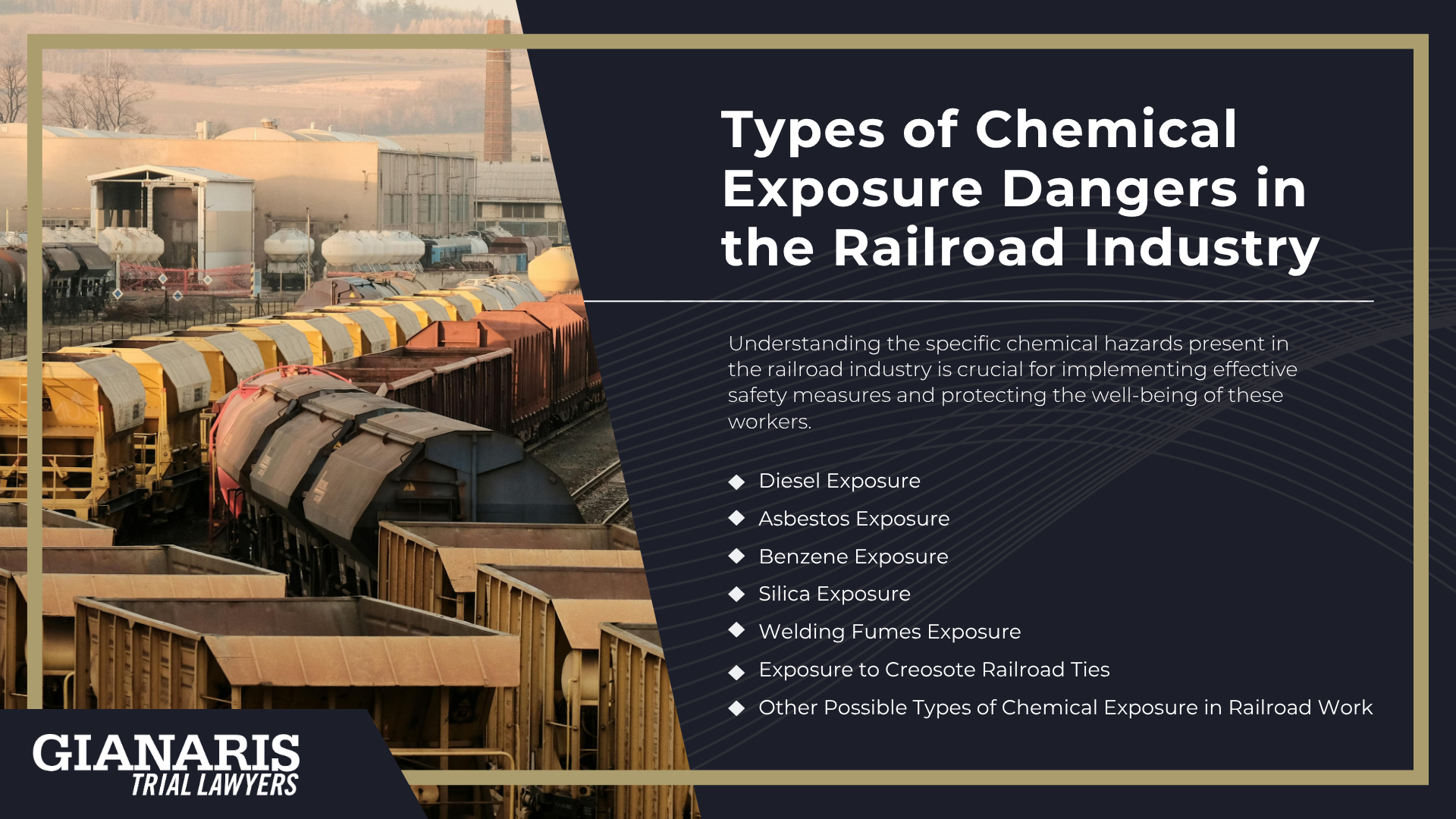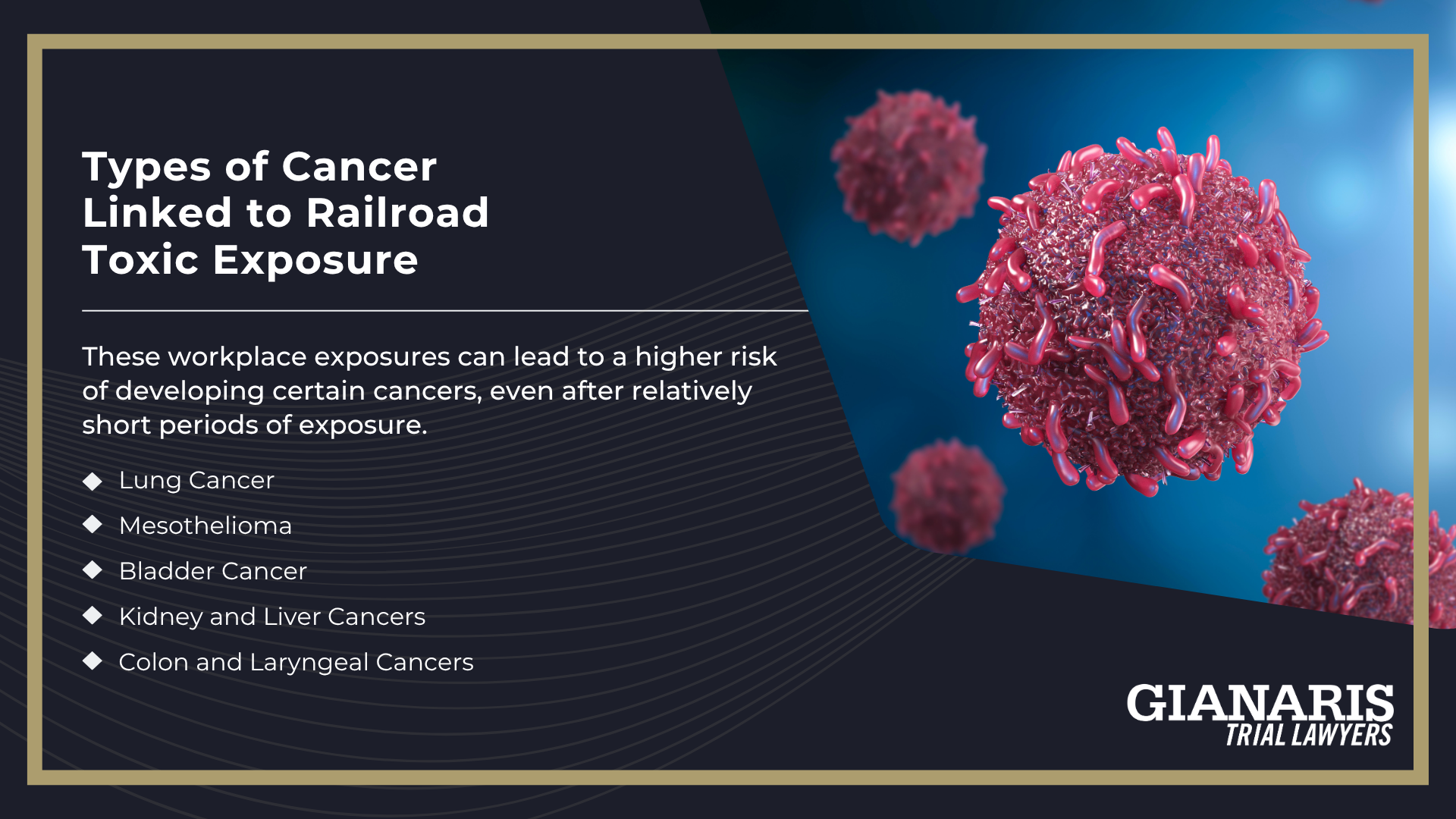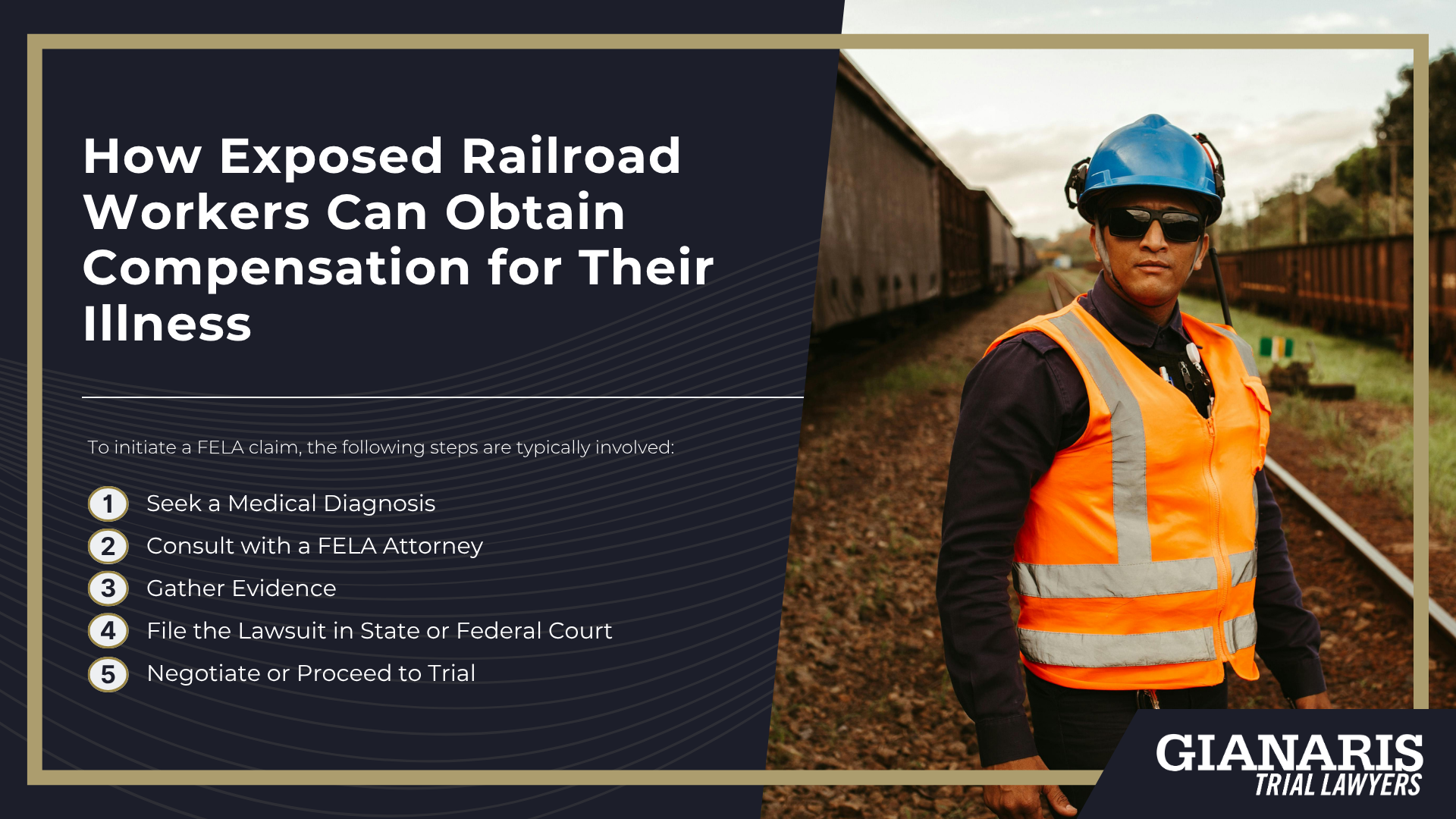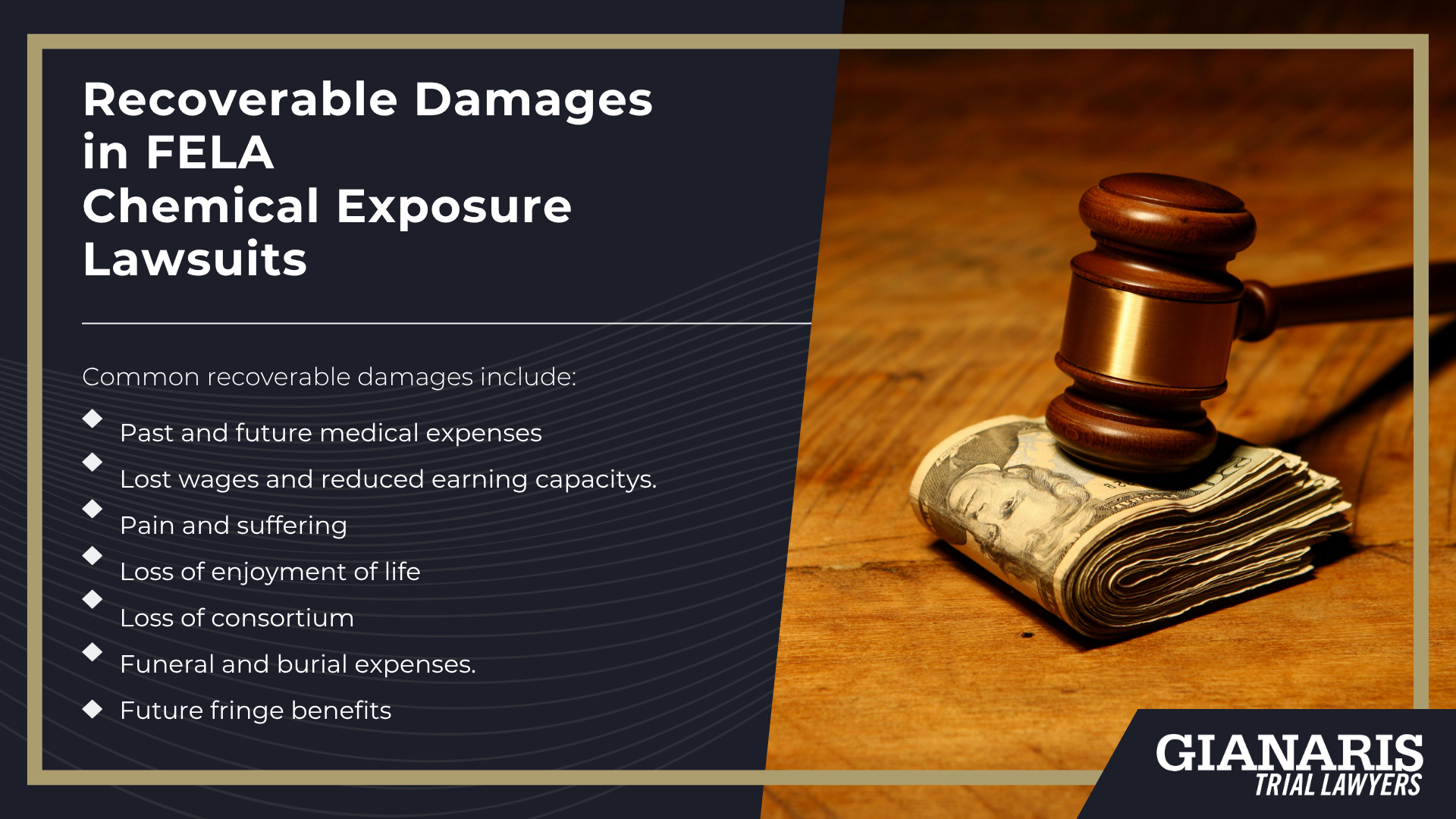Railroad workers face significant health risks due to prolonged exposure to various toxic substances encountered during their daily operations.
These occupational exposures can lead to severe health conditions, including lung cancer, chronic obstructive pulmonary disease (COPD), and other serious illnesses.
Understanding the specific chemical hazards present in the railroad industry is crucial for implementing effective safety measures and protecting the well-being of these workers.

Diesel Exposure
Diesel exhaust exposure is a significant occupational hazard in the railroad industry, particularly affecting workers such as locomotive engineers, conductors, and maintenance crews who operate in environments with high concentrations of diesel fumes.
Diesel exhaust is a complex mixture of gases and fine particles, including known carcinogens like benzene and formaldehyde.
Prolonged exposure to these substances has been linked to an elevated risk of developing lung cancer and other respiratory diseases.
A study published in the journal Environmental Monitoring and Assessment utilized the U.S. Environmental Protection Agency’s Integrated Risk Information System (IRIS) risk assessment methodology to quantify the cancer risk posed to railroad workers due to occupational inhalation exposure to diesel exhaust.
The study concluded that “occupational exposure to diesel exhaust in the railroad work environment causes a significant and quantifiable increase in cancer risk to railroad workers“.
The National Institute for Occupational Safety and Health (NIOSH) has recognized diesel exhaust as a potential occupational carcinogen and recommends that employers reduce workers’ exposures.
NIOSH has stated that there is “no known safe level” of exposure to carcinogens such as diesel exhaust.
The International Agency for Research on Cancer (IARC) has classified diesel engine exhaust as “carcinogenic to humans,” based on sufficient evidence that it is linked to an increased risk of lung cancer.
IARC also notes that there is “some evidence of a positive association” between diesel exhaust and bladder cancer.
Railroad workers with prolonged diesel exhaust fume exposure, perhaps more than 20 years, and a diagnosis of lung cancer or chronic obstructive pulmonary disease (COPD) coupled with medical confirmation of abnormal pulmonary function/breathing tests should seek information on whether their condition could have been caused by diesel exhaust fume exposure.
Workers exposed to diesel fumes should be aware of the associated risks and take appropriate measures to protect their health.
Asbestos Exposure
Asbestos, prized for its heat resistance and insulating properties, was extensively used in the railroad industry throughout much of the 20th century.
It was commonly found in components such as pipe insulation, brake linings, gaskets, boilers, and electrical panels.
Railroad workers—including engineers, conductors, maintenance crews, and shop workers—were frequently exposed to asbestos fibers during the installation, repair, or removal of these materials.
Even short-term exposure to disturbed asbestos-containing materials could release airborne fibers, posing significant health risks.
Inhalation of asbestos fibers is associated with serious diseases, including asbestosis, lung cancer, and mesothelioma—a rare and aggressive cancer affecting the lining of the lungs or abdomen.
Notably, mesothelioma can develop decades after initial exposure, and cases have been documented even in individuals with brief exposure periods.
The U.S. Occupational Safety and Health Administration (OSHA) has stated that there is no known safe level of asbestos exposure.
Studies have demonstrated a direct link between asbestos exposure in railroad workers and increased incidences of mesothelioma and other asbestos-related diseases.
A 1991 study published in Toxicology and Industrial Health analyzed mesothelioma cases among railroad workers and found that asbestos present in rail equipment posed significant health risks.
The widespread use of asbestos in the railroad industry has had long-term health implications for many workers. Asbestos-containing materials in older trains and facilities continue to pose risks, especially during maintenance or renovation activities that disturb these materials.
It’s crucial for current and former railroad employees to be aware of their potential exposure and to seek medical evaluation if they experience symptoms associated with asbestos-related diseases.
Benzene Exposure
Benzene is a volatile organic compound found in crude oil and diesel fuel, making it a significant concern for railroad workers.
Classified as a Group 1 carcinogen by the International Agency for Research on Cancer (IARC), benzene exposure has been linked to various forms of cancer, including acute myeloid leukemia (AML), multiple myeloma, and non-Hodgkin’s lymphoma.
Railroad employees may encounter benzene through several occupational routes, often without adequate protective measures.
Common routes of benzene exposure in railroad work include:
- Inhalation of diesel exhaust: Benzene is a component of diesel fuel; workers such as locomotive engineers and yard crews may inhale fumes during operations.
- Use of degreasing solvents: Maintenance workers and shop employees often use cleaning agents containing benzene, leading to inhalation or skin contact.
- Handling of treated materials: Railroad ties and other materials treated with chemicals may release benzene vapors, especially during maintenance activities.
- Spill response and cleanup: Workers involved in cleaning up fuel spills or leaks may be exposed to high concentrations of benzene.
Even moderate exposure over a short period can be hazardous, but prolonged exposure over a long period significantly increases health risks.
A study highlighted that workers exposed to benzene for extended durations faced a higher incidence of blood-related cancers.
Symptoms of benzene exposure can be subtle initially but may progress to serious health conditions.
The Occupational Safety and Health Administration (OSHA) has set permissible exposure limits for benzene at 1 part per million (ppm) over an 8-hour workday and a short-term exposure limit of 5 ppm over any 15-minute period.
However, these limits may not fully protect against the long-term effects of benzene exposure, especially in environments where safety protocols are not strictly enforced.
Silica Exposure
Silica exposure presents a significant occupational hazard for railroad workers, particularly those involved in track maintenance and repair.
Crystalline silica, a component of materials like granite and sand, is prevalent in railroad ballast—the crushed rock foundation supporting tracks.
When workers engage in activities such as cutting, drilling, or disturbing ballast, fine silica dust particles can become airborne and inhaled, leading to serious health risks.
A study highlighted that maintenance-of-way railroad employees are exposed to hazardous levels of respirable crystalline silica from ballast, with many samples exceeding OSHA’s permissible exposure limits.
The Centers for Disease Control and Prevention (CDC) notes that millions of U.S. workers are exposed to respirable crystalline silica.
The Occupational Safety and Health Administration (OSHA) has established a permissible exposure limit (PEL) for respirable crystalline silica at 50 micrograms per cubic meter of air, averaged over an 8-hour workday.
Despite these regulations, studies have found that a significant number of samples collected from railroad workers exceed these limits.
Welding Fumes Exposure
Welding is an essential part of railroad maintenance and construction, used extensively in repairing tracks, fabricating parts, and maintaining rolling stock.
Tasks such as joining rails, maintaining railcars, and repairing metal infrastructure require frequent welding, often in confined spaces such as locomotive shops, undercarriages, or inside railcars.
These environments can restrict airflow, causing the buildup of welding fumes, which are created when metals are heated above their boiling points and condense into fine, airborne particles.
Railroad workers—especially welders, pipefitters, and shop workers—may be exposed during gas metal arc welding (GMAW), shielded metal arc welding (SMAW), and flux-cored arc welding (FCAW), all of which are common in the railroad industry.
Exposure routes include inhalation of airborne metal fumes containing substances like manganese, chromium, iron oxide, and sometimes lead or cadmium depending on the material being welded.
Prolonged work without proper local exhaust ventilation, especially during emergency repairs on-site or in aging shop facilities, exacerbates the risk of exposure.
According to the National Institute for Occupational Safety and Health (NIOSH), welding fume exposure has been linked to adverse pulmonary outcomes and neurological effects, even when exposure levels are considered moderate or intermittent.
A 2018 study published in the Journal of Occupational and Environmental Hygiene highlighted that welders working indoors or in sheltered outdoor spaces experienced significantly higher fume concentrations than those welding in well-ventilated open-air environments.
Despite safety regulations, many older maintenance depots still lack modern ventilation systems, and personal protective equipment (PPE) may be inconsistently used or improperly fitted.
Because welding is so critical to railroad upkeep, workers are often required to perform welding duties daily or for long shifts—especially during large infrastructure upgrades or accident-related repairs.
These operational demands increase the likelihood of repeated exposure and insufficient recovery time, compounding the health risks over the course of a railroad worker’s career.
Exposure to Creosote Railroad Ties
Creosote, a tar-based preservative derived from coal tar distillation, has been used for over a century to treat wooden railroad ties, making them resistant to rot, insects, and moisture.
In the railroad industry, thousands of miles of track are supported by these treated ties, which are handled, installed, and removed by trackmen, maintenance-of-way crews, and equipment operators.
Workers involved in tasks such as cutting, drilling, or replacing creosote-treated ties are regularly exposed through direct skin contact and the inhalation of volatile organic compounds (VOCs) released from the material—particularly during warm weather or when the ties are freshly cut.
The exposure risk increases significantly when workers operate in poorly ventilated areas or use mechanized tools that generate dust and debris.
Tasks such as grinding, sawing, and tamping near or on creosote-treated ties can aerosolize particles, leading to respiratory exposure.
Creosote can also transfer from gloves and clothing to the skin and mouth, creating indirect ingestion pathways if workers eat, smoke, or wipe their faces without cleaning up.
Shop workers and maintenance crews working near stored ties or creosote-treated lumber may also encounter vapors and residues in enclosed areas.
Scientific literature supports concerns about these exposure pathways.
The Agency for Toxic Substances and Disease Registry (ATSDR) notes that creosote can release carcinogenic PAHs (polycyclic aromatic hydrocarbons), and long-term occupational exposure has been documented in railroad settings.
A 2005 study published in Environmental Research found detectable levels of PAH biomarkers in the urine of railroad maintenance workers exposed to creosote, even after brief contact periods, demonstrating both the persistence and potency of exposure routes.
The combination of high-contact tasks and limited personal protective measures on older rail systems continues to make creosote a significant exposure hazard for modern railroad workers.
Other Possible Types of Chemical Exposure in Railroad Work
Rail yards, maintenance shops, and freight corridors are dynamic, industrial environments where chemical exposure risks go far beyond the well-known hazards of diesel exhaust, asbestos, and creosote.
Railroad employees regularly work around heavy machinery, industrial solvents, and materials used for track maintenance or cargo transport—any of which may release harmful substances into the air or onto the skin.
These exposures can be acute or long-term and may occur during routine duties, accidents, or even due to insufficient protective measures.
Additional chemical hazards in the railroad industry include:
- Industrial Solvents – Used in cleaning engines, metal parts, and shop equipment. Exposure may occur through inhalation or skin contact in poorly ventilated workshops or during spill cleanup.
- Lead-Based Paints – Found in older locomotives and infrastructure. Sanding, cutting, or repainting surfaces can release lead dust, exposing painters, welders, and maintenance workers.
- Herbicides – Commonly sprayed along rail lines to prevent vegetation overgrowth. Track workers or inspectors may inhale these chemicals or absorb them through the skin during application or after contact with treated surfaces.
- Pesticides – Occasionally used in storage areas, boxcars, or facilities to control pests. Workers entering recently treated areas may be exposed without warning.
- Freight Spills and Leaks – Railroads often transport hazardous materials, including fuels, chemicals, and industrial waste. Accidents, derailments, or leaking containers can expose cleanup crews and nearby workers to dangerous chemicals.
- Hydraulic Fluids and Lubricants – Used in brake systems and other mechanical parts. Spills and leaks in maintenance areas may lead to skin contact or inhalation of vapors.
- Battery Acids – Present in locomotive and signal batteries. Handling damaged batteries or working in confined battery rooms without proper ventilation can be hazardous.
Even when these chemicals are not part of a worker’s primary duties, incidental contact, inadequate protective gear, or improper hazard communication can result in significant exposure.
Over time, these exposures may contribute to chronic health conditions or elevate cancer risks, making documentation and legal review critical for any affected worker.









